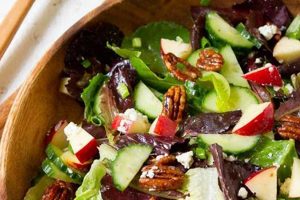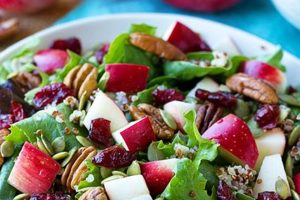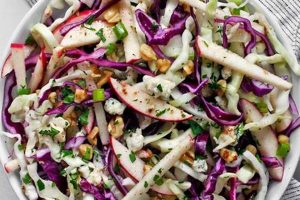This dish typically features a combination of chopped apples, a rich caramel sauce, and chopped Snickers candy bars, often bound together with a creamy base such as whipped cream or Cool Whip. Variations may include additional ingredients like nuts, raisins, or other candies. It serves as a sweet side dish or dessert, frequently appearing at potlucks, holiday gatherings, and other social events.
The appeal of this dessert salad lies in its contrasting textures and flavors. The crispness of the apples complements the chewy caramel and the satisfying crunch of the Snickers. The combination of sweet and salty elements, derived from the caramel and the peanuts within the candy bars, offers a balanced flavor profile. Its relative ease of preparation and adaptability contribute to its enduring popularity. While its precise origins are unclear, it likely emerged as a popular dish sometime in the late 20th century alongside the growing trend of dessert salads in American cuisine.
Further exploration will delve into specific variations of this dessert, including ingredient substitutions, preparation methods, and nutritional information. Tips for presentation and serving suggestions will also be provided.
Tips for a Successful Dessert Salad
Achieving optimal flavor and texture requires attention to several key aspects of preparation.
Tip 1: Apple Selection: Tart apples, such as Granny Smith or Honeycrisp, provide a desirable contrast to the sweetness of the caramel and candy. Softer apples should be avoided as they may become mushy.
Tip 2: Caramel Consistency: Homemade or store-bought caramel can be used. If using store-bought, ensure it is thick enough to coat the apples without becoming runny. Warming slightly can improve its pourability.
Tip 3: Snickers Preparation: Chop the Snickers bars into bite-sized pieces. Freezing the bars briefly before chopping can facilitate cleaner cuts.
Tip 4: Creamy Base Options: While whipped cream and Cool Whip are common choices, alternatives such as Greek yogurt or a stabilized whipped cream can offer a lighter, less sweet option.
Tip 5: Ingredient Incorporation: Gently fold the ingredients together to prevent overmixing, which can lead to a less desirable texture.
Tip 6: Chill Time: Chilling the salad for at least 30 minutes allows the flavors to meld and the apples to absorb some of the caramel.
Tip 7: Serving Suggestions: This dish can be served in a large bowl, individual dessert cups, or even on small plates. Garnish with a sprinkle of chopped nuts or a drizzle of extra caramel.
Attention to these details ensures a balanced, visually appealing, and flavorful result.
By following these tips, a consistently satisfying dessert can be achieved.
1. Apples (variety, texture)
Apple selection significantly influences the overall balance and enjoyment of this dessert salad. The variety chosen dictates not only the flavor profile but also the structural integrity of the salad after mixing with the other ingredients. Understanding the interplay between apple variety and texture is crucial for a successful outcome.
- Sweetness vs. Tartness
Balancing the sweetness of the caramel and Snickers requires careful consideration of the apple’s inherent sweetness. Sweeter apple varieties, such as Fuji or Gala, can result in an overly sweet salad. Tart varieties, like Granny Smith or Braeburn, provide a necessary counterpoint, enhancing the complexity of the overall flavor profile. The tartness also cuts through the richness of the caramel and creamy base, creating a more refreshing experience.
- Texture and Structural Integrity
The apple’s texture contributes to the salad’s overall mouthfeel. Firm, crisp apples like Honeycrisp or Pink Lady maintain their shape and provide a satisfying crunch even after being coated in caramel and mixed with the other components. Conversely, softer apples, such as McIntosh or Red Delicious, tend to break down more easily, resulting in a mushy texture that detracts from the desired contrast.
- Flavor Complexity
Beyond simple sweetness or tartness, different apple varieties offer unique flavor notes that can complement or contrast with the other ingredients. For example, Granny Smith apples have a slightly acidic, almost grassy flavor that pairs well with the nutty notes of the Snickers. Honeycrisp apples, on the other hand, have a sweeter, more floral aroma that adds another layer of complexity.
- Visual Appeal
The color of the apple also plays a role in the salad’s visual presentation. The bright green of a Granny Smith apple offers a pleasing contrast to the brown caramel and the colorful Snickers pieces. Red-skinned apples, while visually appealing, may not offer the same level of contrast and can sometimes bleed their color into the creamy base.
Ultimately, the choice of apple variety impacts the final product’s flavor, texture, and visual appeal. Selecting a firm, tart apple ensures a balanced and enjoyable dessert salad experience. Careful consideration of these factors allows for customization and optimization of this popular dish.
2. Caramel (homemade, store-bought)
Caramel plays a crucial role in this dessert salad, binding the ingredients and contributing a significant portion of the flavor profile. The choice between homemade and store-bought caramel impacts both the preparation process and the final result. Understanding the nuances of each option allows for informed decision-making.
- Flavor Profile
Homemade caramel offers greater control over flavor nuances, allowing for customization based on personal preferences. Ingredients like butter, sugar, cream, and vanilla extract can be adjusted to achieve specific flavor profiles, from a deep, almost burnt caramel to a lighter, sweeter version. Store-bought caramel provides convenience but often has a more standardized flavor profile, typically leaning towards a sweeter, less complex taste.
- Texture and Consistency
The texture of the caramel significantly impacts the salad’s overall consistency. Homemade caramel allows for precise control over the final texture, ranging from a smooth, pourable sauce to a thicker, chewier caramel. Store-bought caramel comes in various consistencies, but achieving the ideal texture for the salad may require adjustments like warming or cooling. A caramel that is too thin will not adequately coat the apples, while a caramel that is too thick will be difficult to incorporate evenly.
- Preparation Time and Effort
Homemade caramel requires more time and effort, involving careful cooking and monitoring of the sugar as it caramelizes. This process demands attention to detail to avoid burning or crystallization. Store-bought caramel offers a significant time-saving advantage, requiring no preparation beyond potentially warming or softening.
- Cost Considerations
While the ingredient cost of homemade caramel may be relatively low, the time investment should be considered. Store-bought caramel can be more expensive depending on the brand and quality but offers convenience that may be valuable for some individuals.
The choice between homemade and store-bought caramel ultimately depends on individual priorities and preferences. While homemade caramel allows for greater control over flavor and texture, store-bought caramel offers convenience. Careful consideration of these factors ensures the caramel complements the other ingredients and contributes to a successful dessert salad.
3. Snickers (chopped, quantity)
The incorporation of Snickers bars distinguishes this dessert salad, contributing a unique blend of flavors and textures. Quantity and preparation of the Snickers directly influence the overall balance and enjoyment of the dish. Several factors merit consideration.
Size and Texture: Chopping the Snickers into bite-sized pieces ensures even distribution throughout the salad and a pleasant textural experience. Larger pieces may create an imbalance of sweetness and disrupt the creamy consistency. Finely chopped Snickers, conversely, might become lost among the other ingredients. Freezing the candy bars before chopping facilitates cleaner cuts and prevents excessive crumbling.
Flavor Balance: The inherent sweetness of Snickers, derived from the nougat, caramel, and milk chocolate, must be balanced against the tartness of the apples and the richness of the caramel sauce. An excessive quantity of Snickers can overpower the other flavors, while too little might render the salad bland. The ratio of Snickers to other ingredients dictates the final flavor profile, allowing for customization based on individual preferences.
Textural Contrast: The contrasting textures within the Snickers bar itself the chewy nougat, the crunchy peanuts, and the smooth chocolate add another layer of complexity to the salad. This interplay of textures, combined with the crispness of the apples and the creaminess of the base, creates a multi-sensory experience. Proper chopping ensures these textural elements are preserved and contribute to the overall enjoyment.
Practical Application: Consider a scenario where an individual prepares the salad with whole or coarsely chopped Snickers bars. The resulting distribution of sweetness and texture would be uneven, with some bites overwhelmingly sweet and others lacking the characteristic Snickers flavor. Conversely, finely chopping the bars might lead to a loss of textural contrast and a less pronounced Snickers presence. A balanced approach to chopping and quantity is essential for achieving optimal results.
Careful consideration of Snickers preparation and quantity is fundamental to a successful outcome. Balancing the distinct flavors and textures of the Snickers with the other components ensures a harmonious and enjoyable dessert salad experience.
4. Creamy Base (whipped cream, alternatives)
The creamy base serves as a unifying element in this dessert salad, binding the diverse components and contributing to the overall texture and flavor profile. Selection of this base significantly influences the final product’s richness, sweetness, and stability. Understanding the various options and their respective characteristics allows for informed decision-making and customization.
- Traditional Whipped Cream
Whipped cream, made by whipping heavy cream with sugar and often vanilla extract, provides a classic, rich, and airy texture. Its sweetness complements the other ingredients while its light texture prevents the salad from becoming overly dense. However, whipped cream can be prone to deflation over time, affecting the salad’s presentation and potentially leading to a watery consistency if made too far in advance.
- Stabilized Whipped Cream
Stabilized whipped cream incorporates ingredients like gelatin or cream cheese to increase its stability and prevent deflation. This option is particularly beneficial for large gatherings or situations where the salad needs to hold its shape for an extended period. While maintaining a similar flavor profile to traditional whipped cream, the added stabilizers can slightly alter the texture, making it denser and less airy.
- Cool Whip (Non-Dairy Topping)
Cool Whip, a non-dairy whipped topping, offers a lighter and sweeter alternative to traditional whipped cream. Its stability makes it suitable for situations requiring advance preparation. However, its distinct flavor profile and slightly artificial sweetness may not appeal to all palates. It also lacks the same richness and mouthfeel as dairy-based whipped cream.
- Greek Yogurt
Greek yogurt provides a tangier and less sweet option, offering a contrasting flavor profile to the other ingredients. Its thicker consistency contributes to a denser salad and can offer a healthier alternative due to its higher protein content. However, its tartness may not complement the overall flavor profile for those seeking a predominantly sweet dessert.
The choice of creamy base directly impacts the dessert salad’s overall flavor, texture, and stability. While traditional whipped cream provides a classic, rich experience, stabilized whipped cream offers enhanced stability. Cool Whip provides a lighter, sweeter, and more stable alternative, while Greek yogurt introduces a tangy contrast. Careful selection of the creamy base allows for customization and optimization of the final product, ensuring a harmonious balance of flavors and textures.
5. Optional additions (nuts, raisins)
Optional additions represent an opportunity to personalize and enhance the flavor and textural complexity of the apple caramel snicker salad. These additions, while not essential to the core recipe, provide avenues for customization based on individual preferences and dietary considerations. Understanding the potential contributions of various additions allows for informed choices that elevate the overall sensory experience.
- Textural Contrast
Nuts, such as chopped pecans, walnuts, or peanuts, introduce a satisfying crunch that contrasts with the softer elements of the salad. This textural variation enhances the overall mouthfeel, creating a more dynamic and engaging culinary experience. The choice of nut can also influence the flavor profile; pecans offer a buttery richness, while walnuts contribute a slightly earthy note.
- Flavor Enhancement
Raisins, dried cranberries, or other dried fruits contribute a concentrated sweetness and chewiness. This complements the sweetness of the caramel and Snickers, while also adding a subtle tartness depending on the fruit chosen. The choice of dried fruit allows for customization based on individual flavor preferences, ranging from the traditional sweetness of raisins to the tartness of cranberries.
- Nutritional Considerations
Incorporating nuts and seeds, such as sunflower or pumpkin seeds, introduces nutritional benefits, including healthy fats, protein, and fiber. These additions can contribute to a more balanced nutritional profile for the dessert salad, while also enhancing the textural complexity. However, portion control remains important due to the calorie density of nuts and seeds.
- Balancing Flavors
Toasted coconut flakes offer a unique sweetness and a delicate, slightly chewy texture that complements the other ingredients. The subtle toastiness of the coconut enhances the caramel notes, adding another layer of complexity to the flavor profile. The delicate texture of coconut flakes prevents them from overpowering the other textural elements in the salad.
Judicious incorporation of optional additions can significantly elevate the apple caramel snicker salad. By considering the interplay of textures, flavors, and nutritional value, individuals can personalize this classic dessert to suit individual preferences and create a more nuanced and satisfying culinary experience.
Frequently Asked Questions
This section addresses common inquiries regarding the preparation and variations of this dessert salad.
Question 1: Can other types of candy bars be substituted for Snickers?
While Snickers provide a characteristic flavor and texture profile, other candy bars can be substituted. Alternatives like Milky Way, Twix, or Butterfinger offer different flavor combinations and textural elements, allowing for customization based on individual preferences. Consider the candy bar’s sweetness, texture, and flavor components when making substitutions to ensure compatibility with the other ingredients.
Question 2: How long can the salad be stored in the refrigerator?
Optimal flavor and texture are maintained for up to two days when refrigerated in an airtight container. Beyond this timeframe, the apples may begin to soften excessively, and the whipped cream or other creamy base can lose its stability.
Question 3: Can this salad be made ahead of time for a large gathering?
Advance preparation is possible, but certain considerations ensure optimal quality. Chopping the apples, preparing the caramel, and chopping the Snickers can be done a day in advance. However, combining all ingredients is best done within a few hours of serving to prevent the apples from becoming soggy and the creamy base from losing its structure.
Question 4: Are there healthier alternatives for the creamy base?
Greek yogurt or a mixture of Greek yogurt and whipped cream offer a lighter, higher-protein alternative to traditional whipped cream or Cool Whip. These options reduce overall fat and calorie content while contributing a tangy flavor that complements the other ingredients.
Question 5: Can the caramel be made without refined sugar?
Alternatives like coconut sugar or maple syrup can be used to make caramel, but the process and final outcome may differ. These alternatives can alter the caramel’s flavor, texture, and cooking time. Experimentation may be necessary to achieve desired results.
Question 6: What types of apples are best suited for this recipe?
Firm, tart apples like Granny Smith or Honeycrisp are recommended due to their ability to maintain their texture and provide a balancing tartness to the sweetness of the caramel and Snickers. Softer apple varieties may become mushy when combined with the other ingredients.
Addressing these common questions clarifies potential uncertainties regarding ingredient selection, preparation methods, and storage. Informed choices lead to a more successful and enjoyable dessert experience.
The following section explores variations of this recipe, offering further customization options.
Apple Caramel Snicker Salad Recipe
This exploration has provided a comprehensive overview of the apple caramel snicker salad recipe, encompassing ingredient selection, preparation techniques, and potential variations. Emphasis has been placed on the importance of balancing flavors and textures, highlighting the interplay between tart apples, sweet caramel, and the distinctive components of Snickers bars. The creamy base’s role in unifying these elements has been examined, along with the potential contributions of optional additions like nuts and dried fruits.
The enduring popularity of this dessert salad stems from its accessibility, adaptability, and the satisfying harmony of contrasting flavors and textures. Further experimentation with ingredient variations and preparation methods allows for personalized interpretations, ensuring this classic dessert continues to delight a wide range of palates.






